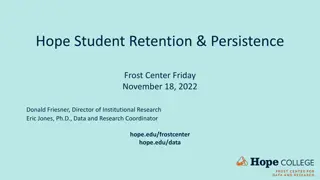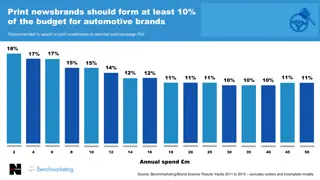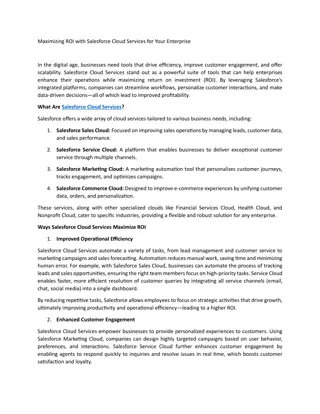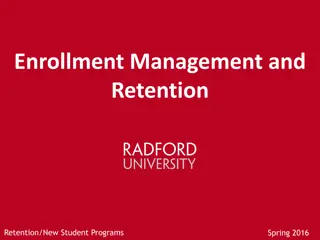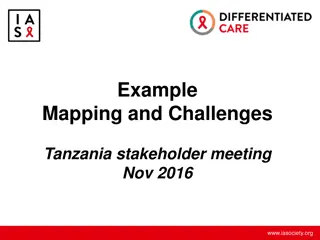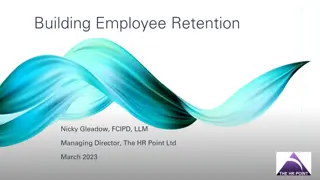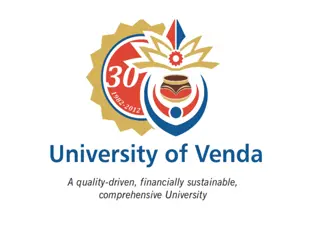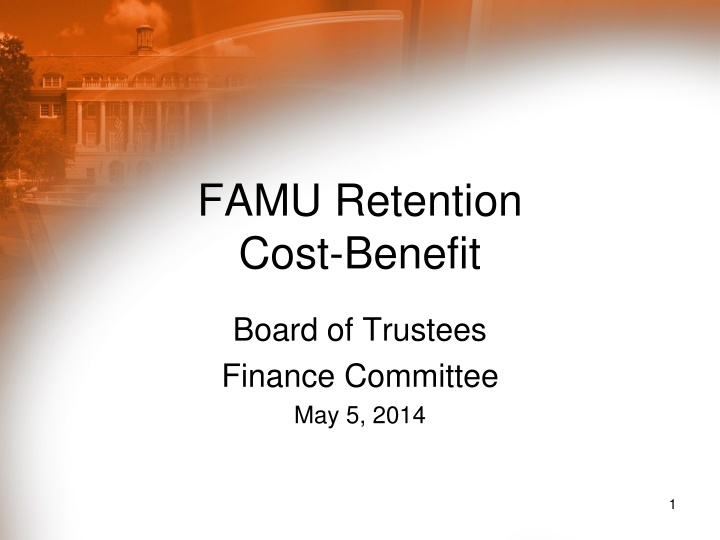
Enhancing Student Retention: Cost-Benefit Analysis and Strategies
Explore the impact of student retention on performance metrics, retention expenditures, current retention efforts, benefits of higher retention rates, fiscal impact of student attrition, and return on investment scenarios. Discover how investments in retention initiatives can lead to improved outcomes and financial benefits for educational institutions.
Download Presentation

Please find below an Image/Link to download the presentation.
The content on the website is provided AS IS for your information and personal use only. It may not be sold, licensed, or shared on other websites without obtaining consent from the author. If you encounter any issues during the download, it is possible that the publisher has removed the file from their server.
You are allowed to download the files provided on this website for personal or commercial use, subject to the condition that they are used lawfully. All files are the property of their respective owners.
The content on the website is provided AS IS for your information and personal use only. It may not be sold, licensed, or shared on other websites without obtaining consent from the author.
E N D
Presentation Transcript
FAMU Retention Cost-Benefit Board of Trustees Finance Committee May 5, 2014 1
Impact of Retention on Performance Base Funding Metrics Performance Based Funding Metrics Metric 1: Percent of Bachelor's Graduates Employed and/or Continuing their Education Further 1 Year after Graduation Metric 3: Average Cost per Undergraduate Degree to the Institution Metric 4: Six Year Graduation Rates (Full-time and Part-time FTIC) Metric 5: Academic Progress Rate (2nd Year Retention with GPA above 2.0) Metric 6: Bachelor's Degrees Awarded in Areas of Strategic Emphasis (includes STEM) Metric 8a: Graduate Degrees Awarded in Areas of Strategic Emphasis (includes STEM) Metric 9:Percent of Bachelor s Degrees without Excess Hours 2
Retention Expenditures (FY 2013-2014) Retention Budget $1.1M E&G (Tuition Differential) $2M Title III Grant 3
Current Retention Efforts Established Office of University Retention (2010) First Year Experience Program Academic Success Programs Restructured Access Summer Bridge Program Debt Management Program Faculty Development 4
Benefits of Higher Student Retention High graduation rates Better quality of life for students Increased career opportunity & earning potential Reduction in student debt Improved Institutional Image/Standings Increased revenue Increased Performance Funding 5
Fiscal Impact of Student Attrition Attrition # of Revenue Loss $4.6M Students 400 First Year Overall 1,200 $10.3M Annual Attrition (based on 3-year average, 2009-2011) Calculation based on tuition, fees, housing, and meal plan Average Revenue Dollars per FTIC Student: $ 9,894.60 (In state)-approximately 87% $21,835.40 (Out-of-state)-approximately 13% 6
Return on Investment Retention Revenue Scenario Retention # of Revenue Revenue Student Persistence $1.2M Students First Year 50 FTIC $572,000 Non-Freshman 75 $540,000 $1.3M Students on SAP 100 Less $719,000 $1.7M Calculation based on tuition, fees, housing, and meal plan Average Revenue Dollars per FTIC Student: $ 9,894.60 (In state)-approximately 87% $21,835.40 (Out-of-state)-approximately 13% 7
Challenges & Opportunities Expand program and services for high- performing students Effective Recruitment Enhance the wrap-around services for first-year students, student athletes, and academically at- risk students Leverage the full power of the technology enterprise to better meet the needs of all constituents 8
Challenges & Opportunities Employ innovative supplemental instruction strategies Enhance Campus Facilities State-of-the-art classrooms and learning spaces Centralized student services facilities Extend faculty and staff development efforts with an orientation towards student success 9
Questions 10






